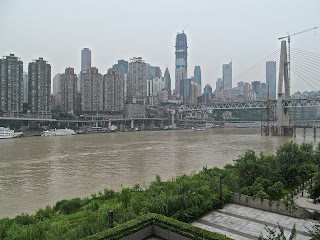 |
| A drive into the outskirts of Chongqing with the purpose of visiting and conversing with educators at a university of teacher preparation turned out to be a big deal. |
 |
| Each of our group was presented with a scroll with specially selected writings from Confucius (I still have to get this translated.). |
 |
| Hanging with Confucius again. |
 |
| The university hosted a 28-plate dinner in our honor. I was using my best etiquette and felt a bit overwhelmed, but honored all the same. |
 |
| A view of Chongqing as we returned to the city. |
While back in Beijing, two cities earlier in my itinerary, we visited a hot pot restaurant. Recall my post called, "The Noodle Dancer." During that interactive dinner, I got my nails done. I know this is going to seem silly and trivial, but sometimes little things lead to bigger events. Well, that nail polish was, by this time, pealing like old paint, and it was driving me crazy! I needed it off and didn't have any nail polish remover. In this south mountain town, I spied a drugstore. The perfect place to pick some up. Scanning the aisles carefully, I couldn't figure out if they had any or not. While I had a rough idea what it might look like, I couldn't read any of the labels. When I finally gave up finding it myself, I enlisted the help of the sales clerk. Through gestures and acting, she figured out what I wanted, I think. She didn't have any.
In the meantime, two girls who looked to be about 12 years old were curious about me and began creeping in a little closer. After exchanging friendly smiles, I posed my question to them. "Is there any nail polish remover here?" I gestured wiping the chipping, purple stuff off of my nails. They seemed to understand what I wanted, and we went from one shop to the next together. No luck. We said good-bye. I thanked them and caught up with some of the others who were shopping/wandering around the outdoor merchants' stalls.
Kitchen utensils, fans (both electric and hand-powered palm leaf styles), fruit, hardware, and a variety of other odds and ends took my attention for some time. Presently, I felt a tap on the shoulder and turned to find the two girls behind me. They had Cheshire Cat smiles on their faces and proudly produced a bottle of nail polish remover. Tah dah! I gushed thankfulness and gratitude and tried to pay them, but they refused to take any money and ran off. I really did try to pay them. In fact, I started after them to try to give them some yuan, but gave it up when another man started yelling at me. To this day I don't know whether that man thought I was trying to hurt the girls, or whether he was just a yeller. I tend to think he was a yeller because he followed me and my group around until we boarded the bus again, all the while talking/yelling. Thing is, even my tour director, who speaks fluent Mandarin, couldn't understand what the man was trying to say. But I digress. The kindness of those girls will not soon be forgotten. In a world where I'm seen as a rich American by many, and someone from whom a few yuan might be made, it was a refreshing reminder that some people just want to make a friendly connection. :)
 |
| The temple in the city. A juxtaposition of tradition and progress |
 |
| Entering the temple in Chongqing. We are here for lectures on Buddhists poetry |
 |
| The temple in Chongqing |
 |
| There are always items available for purchase at temples. Incense, talismans, statues, jewelry... you name it. |
 |
| Places for worshippers |
 |
| Incense for sale |





































